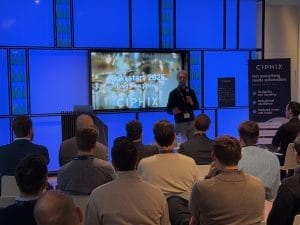AI: from idea to execution
5 December 2024 • Blog

A smart solution for citizens, municipalities, and social workers
Ciphix uses a wide range of technologies: Robotic Process Automation, Low-Code, iPaaS and… Artificial Intelligence (AI). And for good reason. Choosing the right technology for the right task is an important part of our work: what really matters is achieving a successful outcome for you.
But some technologies are harder to understand than others — which means they are also harder to sell within your organisation. (People need proof before they commit.) AI, as a broad and rapidly developing field, is one of those technologies — which is why we often start with new clients with a small-scale first step.
Let’s look at how AI within your organisation can start from one idea — and then grow with your organisation’s needs, without the risks of an all-or-nothing approach on day one.
What is the difference?
Let’s start with a definition. Many automated processes take place “lights off”: the machine performs a task (be it a web application or an industrial robot cutting metal) by simply following a set of rules. An AI software robot is cognitive; it “feels” the data around it and takes actions based on what it discovers. Think of this like an animal in nature, with eyes and ears looking for its next meal.
Cognition has an important advantage
Cognition has an important advantage: it can work with unstructured data. A blind and deaf hamster can survive just fine in a cage, because the food is always in the same place: it is structured. But put him in the woods, and he will have much more problems, because the food is in different places and some things even move: it is an unstructured environment.
The key point: there is far more unstructured data than structured data. From phone calls to handwritten documents, images to videos — most data sets don’t fit into fixed formats. The real world is messy. And since your business is in the real world, so is most of your data.
The good news? It presents opportunities.
Pick a dataset, any dataset. Think of a dataset within your company that could be valuable, if only you had the time to go through it properly. Maybe it’s a folder of customer feedback, a terabyte of recorded customer service calls, or a scanned set of paper reports from engineers. There are all kinds of insights hidden in such data sets — if you know how to find them.
An AI software robot can do that work for you. It discovers patterns and insights into the chaos and converts them into an understandable format. It doesn’t follow a script — it makes value judgments based on criteria you care about.
Finding correlations, making connections
If you want to know why you are attracting so few qualified candidates for your job postings, perhaps the answer could lie in the design of your application form? If the same phrases recur over and over in customer feedback, does that mean there’s a process problem that hasn’t been fixed yet? Or if shopping carts are always abandoned after an hour, does this mean customers are having trouble buying in bulk?
AI can detect the problem — and help you solve it. What’s even better: the same software robot can learn as it “roams” through your data. And that’s where the business advantage comes in. How one group of customers relates to another, and what motivates them. A feature of your corporate image that every customer appreciates in you, but that you had never before recognised as an advantage. A blip in the sales cycle that suggests market turbulence is imminent. AI can detect such insights and inferences, and predict the future landscape, with all its potential, opportunities and risks.
Finding business value in unexpected places
That’s the difference AI offers: it adds a “digital workforce,” not dumb rule-followers, but learning, decisive action-takers. Entities with a wider range of capabilities and the ability to adapt as they discover new information.
That’s the proof you need to demonstrate the value of AI. And here comes the kicker: unlike an idea sketched out on paper, a PoC has already been proven to work. Because it has been developed in the real world, in the context of your actual business processes and information. This provides justification for embracing AI before you roll it out company-wide.
Conclusion: Start small, but scale up quickly
The best part is that there is little risk in starting out. Ciphix can help define the scope for a small initial project, with what we call an AI X-ray: searching through your business to see where AI can add value — often starting with a small-scale project. Once we’ve demonstrated the first piece of value, the real work begins: scaling up the successes within your organisation and looking for more.
Why not show how we can prove the concept? Contact us today!
Related
We will help you further!
Replace outdated systems, digitize complex business processes and accelerate innovation.



